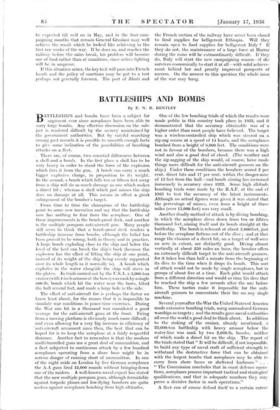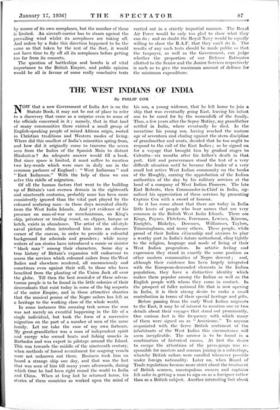BATTLESHIPS AND BOMBS
By E. N. B. BENTLEY /p ATTLESIIIPS and bombs have been a subject for argument ever since aeroplanes have been able to carry large bombs. Any effective discussion on the sub- ject is rendered difficult by the secrecy maintained by the government authorities. But by careful searching among past records it is possible to unearth enough facts to give some indication of the possibilities of bombing attacks on a fleet.
. There arc, of course, two essential differences between a shell and a bomb. In the first place a shell has to be very heavy in order to stand the force of the explosion which fires it from the gun. A bomb can carry a much bigger explosive charge, in proportion to its weight. In the second, a bomb which falls ten or fifteen feet away from a ship will do as much damage as one which makes a direct hit ; whereas a shell which just misses the ship .does no damage at all. This means in effect a great enlargement of the bomber's target.
• From time to time the champions of the battleship point to some new invention and say that the battleship now has nothing to fear from the aeroplane. One of these improvements is the bomb-proof deck, and another is the multiple pompom anti-aircraft gun. Many people still seem to think that a bomb-proof leek renders a battleship immune from bombs, although the belief has been proved to be wrong, both in theory and in practice. A large bomb exploding close to the ship and below the level of the keel can break the ship's back (because the explosion has the effect of lifting the ship at one point, instead of its weight of the ship being evenly supported over its whole length as it normally is). A bomb which explodes in the water alongside the ship will stave in the plates. In trials carried out by the U.S.A. a 5,000-ton cruiser (with 4-inch armour at the bows) was sunk by a single 000-lb. bomb which hit the water near the bows, lifted the hull several feet, and made a large hole in the side: The effect of anti-aircraft fire is perhaps the factor we know least about, for the reason that it is impoSsible to simulate War conditions in peace-time exercises. During the War one hit in a thouSand was considered a good 'average for the anti-aircraft guns at the front. Firing from a Moving platform is obviously much more difficult ; and even allowing for a very big increase in efficiency of 'anti-aircraft armament since then, the best that can be hoped for is to keep the aeroplane at a fairly respectful distance. Another fact to remember is that the modern Multi-barrelled guns use a great deal of ammunition, and a fleet subjected to continuous attack by a few hundred aeroplanes operating from a shore base might be in serious danger of running short of ammunition.- In one of the night raids on London by five German aeroplanes the A-A guns fired 15,000 rounds withOut bringing down one of the raiders. A well-known naval expert has stated that the new multiple pompom guns, although formidable against torpedo planes and low-flying bombers are quite useless against aeroplanes bombing from high altitudes. One of the few bombing trials of which the results were made public in this country took place in 1923, and it demonstrated that the accuracy obtainable was of a higher order than most people have believed. .The target was a wireless-controlled ship which was steered on a zig-zag course at a speed of 14 knots, and the aeroplanes bombed from a height of 8,000 feet. The conditions were not in favour of the bombers, because there was a high wind and also a .good deal of cloud. (The weather and the zig-zagging of the ship would, of course, have made things more difficult for the anti-aircraft gunners on the ship.) Under these conditions the bombers scored. 2 per cent. direct hits and 17 per cent, within the danger zone of 15 feet from the hull—and bomb aiming has increased immensely in accuracy since 1923. Some high altitude bombing trials were made by the R.A.F. at the end of 1935 to test the accuracy of the latest instruments. Although no actual figures were given it was stated that the percentage of misses, even from a height. of .three miles (over 15,000 feet) was very small.
Another deadly method of attack is by diving bombing, in which the aeroplane dives down from ten or fifteen thousand feet, aiming itself and its bomb straight,at the battleship. The bomb is. released at about 2,000 feet, just before the aeroplane flattens out of the dive ; and at that range the chances of a direct hit, on a target of well over an acre in extent, are distinctly good. Diving almost vertically at about 350 miles an hour, the bomber offers an extremely difficult target to the anti-aircraft gunners, for it takes less than half a minute from the -beginning.of its dive to the time when it drops its bomb. This sort of attack would not be made by single aeroplanes, but in groups of about five at a time. Each pilot would attack from a different direction and would so time his dive that he reached the ship a few seconds after the one • before him. These tactics make it impossible for the anti- aircraft gunners to concentrate their fire on any single machine.
Several years after the War the United States of America made extensive bombing trials, using surrendered German warships as targets ; and the results gave naval authorities all over the world a good deal to think about. In addition to the sinking of the cruiser, already mentioned; a 23,000-ton battleship with heavy armour below- the water-line was sunk by two 2,000-lb. bombs, neither of which made a direct hit on the ship. The report of the trials stated that " It will be difficult, if not impossible, to build any type of naval craft of sufficient strength to withstand the destructive force that can be obtained with the largest bombs that aeroplanes may be able to carry from shore bases or sheltered-- harbours " . : . '" The Commission concludes that in coast' defence opera- tions, aeroplanes possess iniportant tactical and strategical qualifications, and that in adequate number's they may prove a decisive factor in such operations."
A fleet can of course defend itself to a certain extent by means of its own aeroplanes, but the number of these is limited. An aircraft-carrier has to steam against the prevailing wind whilst. its aeroplanes are taking off. And unless by. a fluke this direction happened to be the same as that taken by the rest of the fleet, it would not have time to fly off all its aeroplanes before getting too far from its consorts.
The question of battleships and bombs is of vital importance to the British Empire, and public opinion would be all in favour of some really conclusive tests carried out in a strictly impartial manner. The Royal Air Force would be only too glad to show what they can do ; and no doubt the Royal Navy would be equally willing to show the R.A.F. that they can't do it. The results of any such tests should be made public so that the taxpayer, as well as the Government, can judge whether the proportion of our Defence Estimates allotted to the Senior and the Junior Services respectively is such as to give the maximum amount of defence for the minimum expenditure.







































 Previous page
Previous page